Today we’re chatting with the multi-talented An-Magritt W.-Nygaard, author, freelance writer and bestselling novelist in Denmark. We had the pleasure of finding out where she draws her inspiration for her novels, hearing about her many passions and getting a preview of her upcoming novel, her most difficult project yet.
A little bit about An-Magritt Wibell Nygaard-Ech
Please tell us a little about yourself…
Danish-Norwegian author and freelance writer. Interested in most of our world and everything in it. I love cultures, people and helping them. Play the piano, trumpet, like to dance which I also use as training to keep fit. A little bit of everything. Traditional, but open to new things. Use common sense. Denmark is my solid base, but Europe and the world is my playground. Even though Europe is my center. I guard my family like the Scandinavian Lions. Honesty, loyalty, justice are important.
Some call me a cultivated, social, classic, positive person. At times conservative, where my background and upbringing kick in. I love to see the deeper meaning of things and have a taste for little details. I love to give to other people and share.
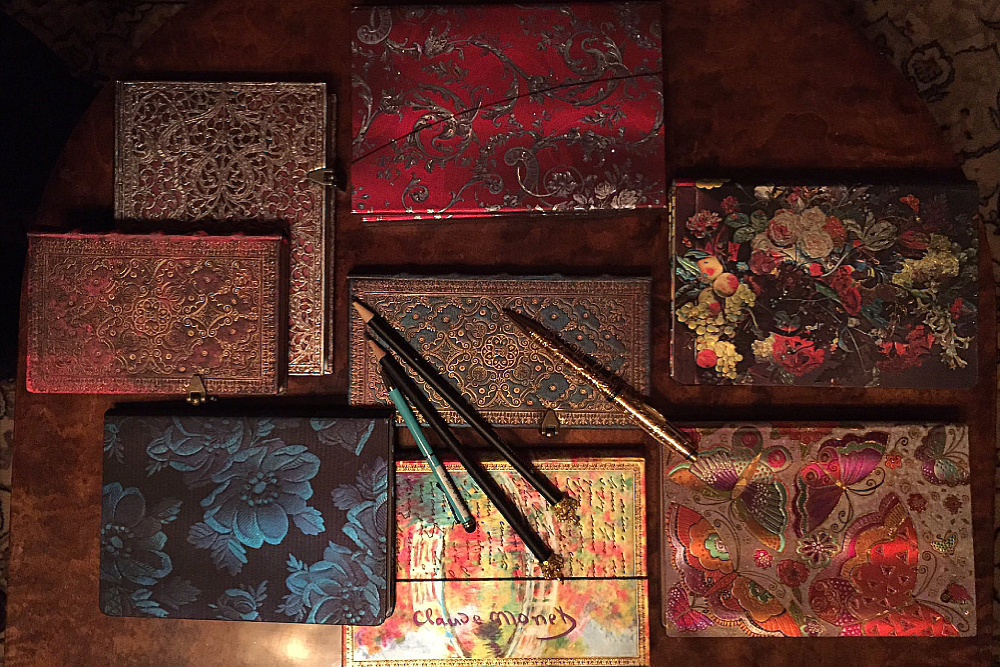
Name: An-Magritt Wibell Nygaard-Ech
Age: Timeless
City/Town/Country: Denmark – Copenhagen area
Places Travelled and/or Lived: Lived in Norway and Denmark. Traveled all around Europe, both east and west. Croatia made a huge impression when I spent many weeks in Dubrovnik, as well as Montenegro, Kotor Bay. It was literally like spending time in a time machine going 1000 years back. At the same time, the country is modern.
Passions: Science is connected to nobility, religion and history through the centuries. Science and archaeology is on top of the list (connects to my interests of discovering a mystery or hidden truth).
Architecture: Because like heraldic it tells a story.
Heraldic: Royalty (not because of the titles, but because of the history behind it).
Nature: Nature is a big part of me.
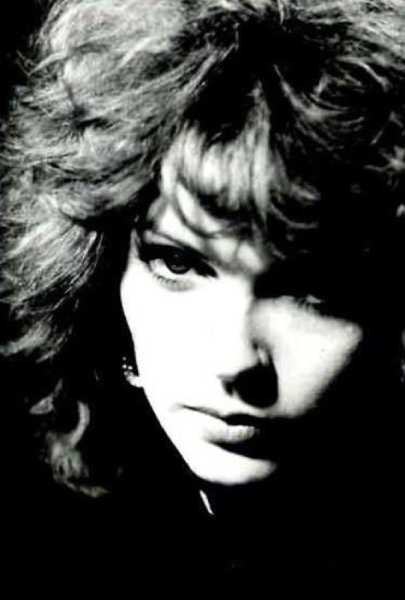
History: My favorite era of history is between 1500 to 1900. I love to see the bigger picture and how it’s connected through our timeline to the present time. The two wars and time between and how it is connected to the present time.
Ancient History: There’s very little I don’t find interesting. Museums too.
Music: I use music as a firestarter and to get back to reality when a script is finished. All genres – from classical, big band and jazz to disco and rock, to mention a few.
Fashion: Vintage, classic Chanel but also modern and casual. It depends on my mood. I love to mix modern with historical design.
Books: If a story captures me, it can be present time and history. Genre is like my musical tastes: everywhere. It’s the storytelling I fall for. And I have a tendency to love mystery. War history – the direct cause of why the world looks like it does. I studied the times right up to the war outbreak, to find out the frictions and what may have led to the war. It’s important and usually one can find the answers to a problem here.
Movies: Deep, realistic, true stories, history – History true stories. Some comic. Forrest Gump is one I never get tired of. Genius put together in a realistic way, mixing historical events into a fictional figure with humor. But also Jane Austen and classical. Dance movies – old movie classics and war movies. An example is Hornblower.
Royalty and nobility
Politics: Monarchist/in the middle. Don’t like the extremes. I could never be a globalist. This will not protect our differences and cultures which I love and make our planet so interesting, unique and colorful. It will destroy it, and I use science to conclude this. That will be fatal for our diversity. To respect it, is to protect it. Each and every culture we have is unique and blooms best where it’s born.
Occupation: Author/freelance writer.
Favourite Quote:
To understand present time, one needs to know the past so one can embrace the future. – Unknown
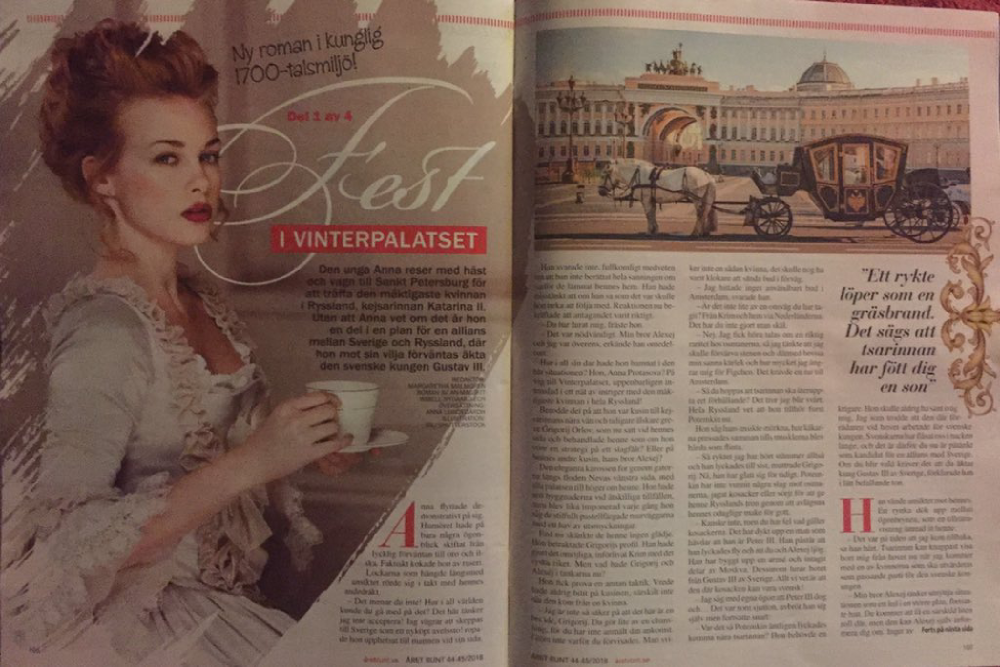
Congratulations on your latest novel series! Can you tell us a bit about the story?
It is the true story of a more unknown story from Czarina Katarina II. Life and court. The lead character is a lady in waiting getting involved in a political game between Russia and Sweden. (Swedish King Gustav III was the cousin of Katarina the Great – both had German origins.) A piece of jewellery has the answer. I researched documents in five countries for this novel series.
You prefer the old-fashioned way of writing your first draft – by hand with pencil. What is it that you like about this form of writing versus a computer?
I prefer the old-fashioned way because of the freedom it gives me. I can take the notebook with me everywhere. Outside, different places in my house. I can sit wherever I want in the position that suits me best.
I feel I can get deeper into my characters by writing by hand. It’s more intimate, more personal. Especially when I write history. It’s necessary for me to do this by hand. I can write little notes on the side, easier and faster, the moment it comes to me. I have to get into the story to the fullest. Catch my inner voice. By handwriting this is easier, since it’s only me, the book and the pen putting my words on the paper.
A computer can sometimes disturb the process. And with less freedom.
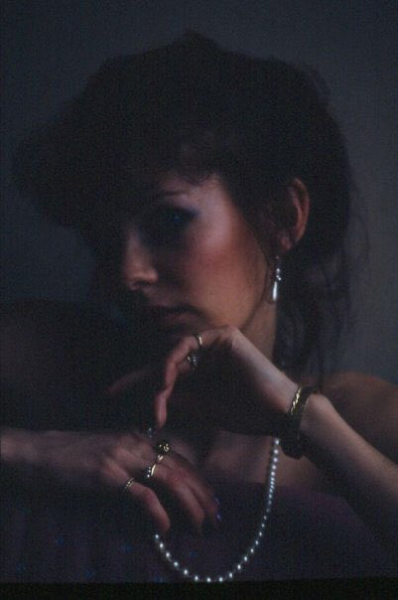
We were so thrilled to hear that you use Paperblanks for all your first drafts. Can you describe your creative/writing process for us?
I catch an unknown detail/happening. I start my research which I always do in primary sources. Old documents, archives. Here is the truth. I start to build it. First a synopsis. Plot – which I prefer to find in our own history. I then use Paperblanks to start writing the first draft. I literally crawl into the notebook. The creating is happening here. And I am totally free to form and create.
When the story is finished, I start to work on the computer. Typing it in, with the Paperblanks book beside me. Adjustments are done in this phase. Then it’s more editing. Again and again.
I suppose it helps when you are inspired by the covers that house your ideas? How else are you inspired for the stories you come up with for your novels?
Not only the covers. It’s the paper inside too. It’s easy to write on. When putting the pen – any pen really – on the paper, it’s easy to write and it glides well. Follows the movement of my hand. Doesn’t leave ink spots either. The little folder in the back I use for notes I have done, a little “memory brain” for me if I need to remember a thread or a special detail – a connection to something in the story.
I use the same book design for each story. Therefore I always have more than one book in every notebook design in your assortment.
You write on a variety of subject matters. Can you tell us more about the different genres you cover?
I cover history and present time. The genre is mystique, war history, psychological drama, soft crime. Realistic relationships. Action.
Which one are you the most drawn to?
History and mystique.
How did you first get into writing?
It started at school. My school essays were always very long and my teacher really had to work for his salary…
My grandfather discovered my writing before me and gave me his old typewriter – a Remington. I did not quite believe him. Later he also gave me my first computer. He did not give up. Today I am very grateful he pushed me to write.
You write for many mediums, including magazines. What do you connect with the most?
Books and magazines. It’s a different way of writing. Magazines are usually more direct, with their word limit for each piece, and this gives me a unique way of training writing. Books I can go deeper. To different constructions and setups.
Has anyone, or anything, in particular inspired your creativity and artistic passion?
For me writing is necessary. I have a story to tell. To share. Something to show. Especially in the history part. My grandfather was the first to inspire me. My big sister is my best critic and mentor, my beloved son, my strength and drive.
One of the novels that was published is a historical piece. Are you drawn particularly to the past both as a writer and for your source inspiration?
Yes, both. Because our history is connected to present time. To deny the facts of history’s happenings, and the people who have been part of this, is to deny our time and who we are. I don’t live in the past, I use it to understand and learn to get the best for the future.
I am drawn to stories and happenings that either are forgotten or purposely hidden.
Any advice you would like to share with aspiring writers?
Write. Many aspiring writers often ask me, also feeling embarrassed, but where do you begin? How do you begin?
I answer that it does not matter where one begins. Remember, nobody is watching when you write. Only you can see it, only you can hear your inner voice. Use this. Write.
The most important part is to start writing, not where you start to write. It can be a sentence, a page. Wherever it fits and what you feel. You can adjust, change along the way. It’s a process. Writing is like everything else – training, training, training.
Do not try to write like a specific author. One can never catch the inner voice of another author. Only our own. Find your style, be yourself. That’s what publishers are looking for.
Are you working on any new projects you would like to share with us?
My most difficult novel so far. It’s about two strong woman in Europe, one in Scandinavia and one in Old Yugoslavia. Present time. They are bound together, but do not know this. It started with a tragic happening in their ancestors’ past outside Scotland in the 16th century where a royal convoy of ships was sent to Scotland for the upcoming wedding between the King of Scotland and Queen Anne (born Princess of Denmark). A noble lady was captured and brought to Constantinople.
A mystery. A war brought the two women together in present time.
It’s a family novel, a war history and a mystery. The story is true. Key words: True history, royalty, nobility, war, refugee, family, mystery, action, love and an emotional journey for both women.
Favourite writer?
Jane Austen, Dan Brown, Voltaire, Philippa Gregory and so incredibly many more…
And finally, do you have a favourite Paperblanks?
Yes – the black gothic design with gold – Nocturnelle.
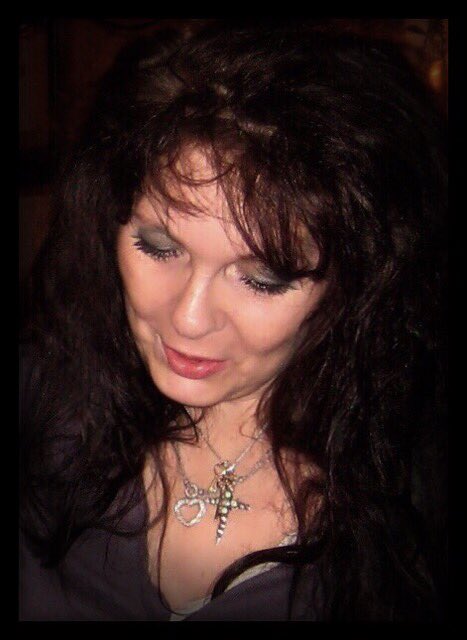
About Paperblanks: When creating our Paperblanks line, we were driven by a desire to keep the beauty of books alive. By drawing inspiration from great artists and craftspeople, our aim is to help you feel inspired and creative every day and to help you create your own personal pieces of art. For more about Paperblanks and our journals, visit our website at paperblanks.com.


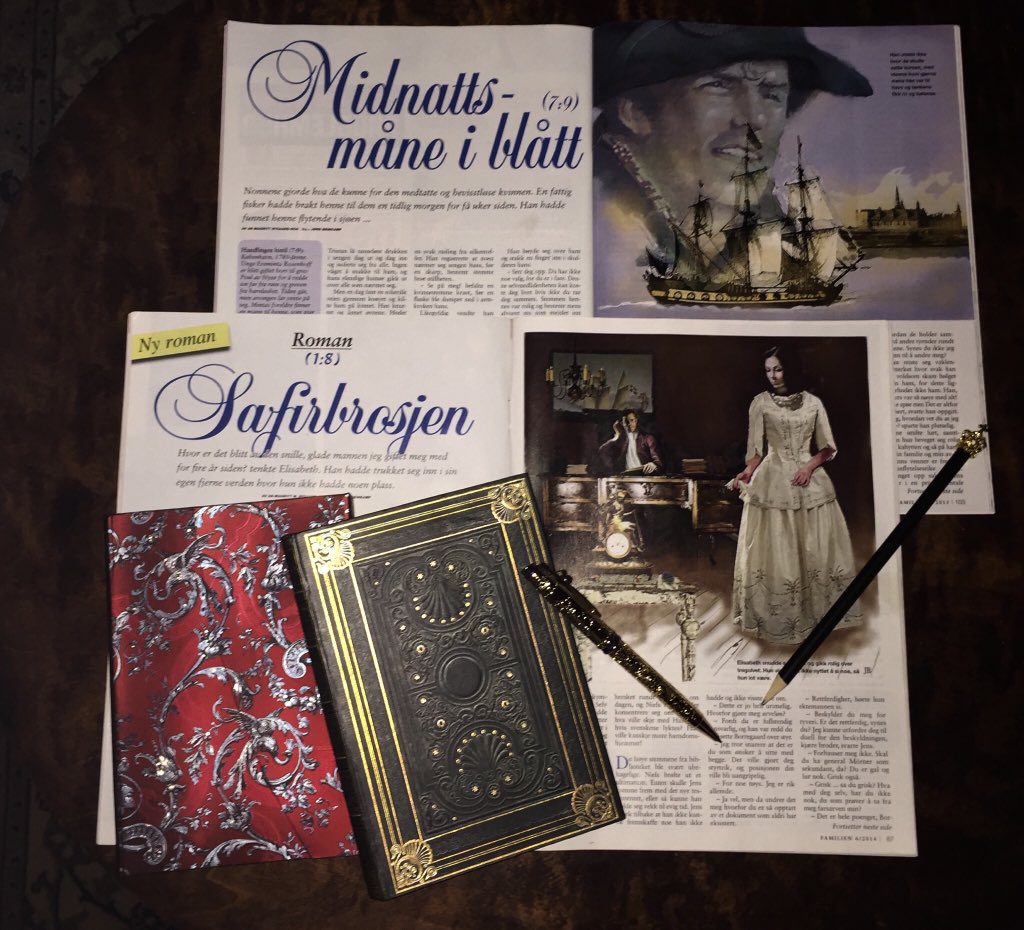

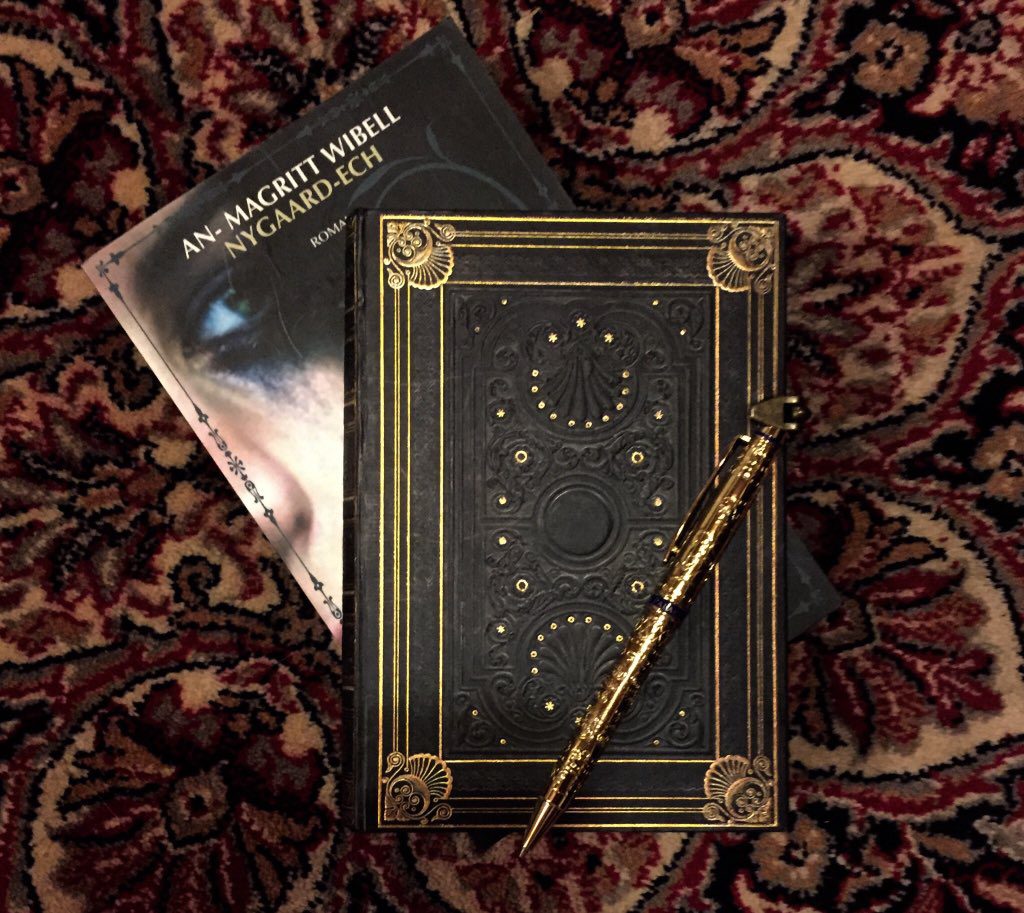


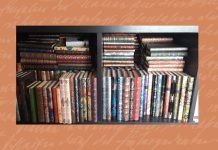

Dejligt interview med den kendte forfatter AN-MAGRITT WIBELL NYGAARD-ECH, udgivet, den 27. december 2018.
Et lille indblik i en forfatters arbejdsmetode og system og baggrund.
Læseværdigt.